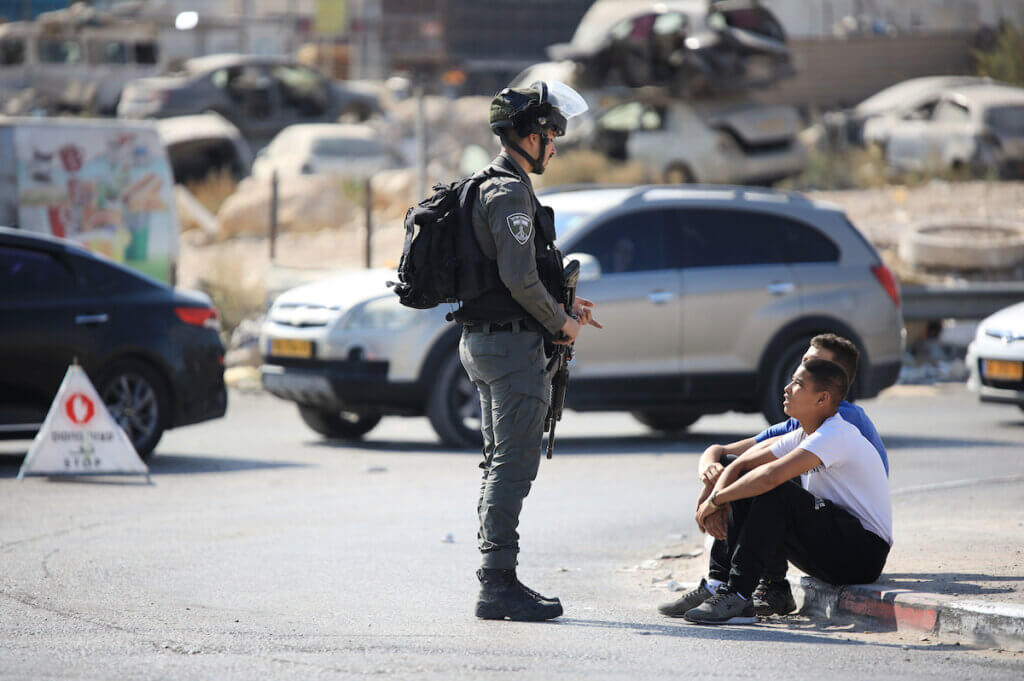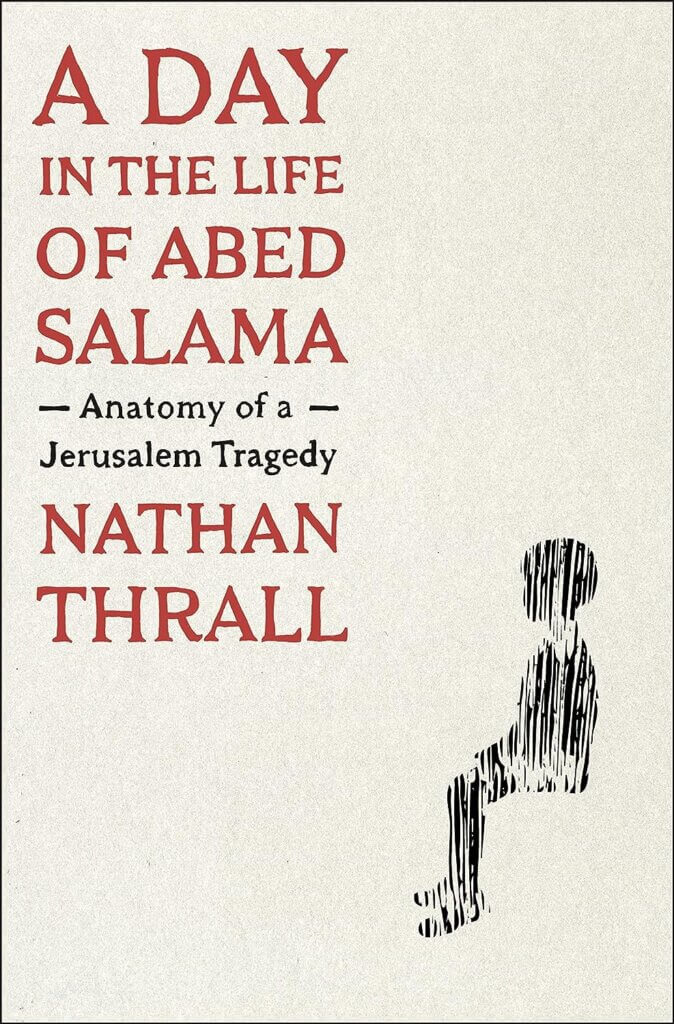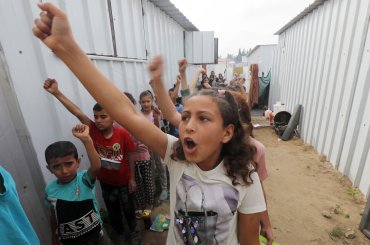A DAY IN THE LIFE OF ABED SALAMA
Anatomy of a Jerusalem Tragedy
by Nathan Thrall
272 pp. Metropolitan Books. $29.99
For years, thoughtful reporters have explained that conveying the truth about Israel’s occupation of Palestine is a challenge. Much of the time, the occupation, now in its sixth decade, simply grinds on, with its most photogenic manifestation being the Palestinian lines at Israeli military checkpoints. Sometimes, such as over the past year or so, Palestinians openly resist — but the mainstream U.S. press usually portrays this breaking news as “Palestinian terrorism” and avoids explaining the background.
But now, Nathan Thrall has found a way. He is a distinguished, experienced reporter, based in Israel/Palestine since 2010. He has even appeared in the New York Times, including a half-dozen opinion articles dating back to 2011, and a comprehensive look at the the Boycott Sanctions Divestment (BDS) movement. And now, Thrall is publishing a major, first-hand account of Israel’s occupation of the West Bank. A Day in the Life of Abed Salama: Anatomy of a Jerusalem Tragedy is already gathering considerable, justified praise.
Here’s how Thrall did it. The central figure in his story is Abed Salama, a dad who lives in Anata, a segregated Palestinian neighborhood of greater Jerusalem. One morning in February 2012, Abed says good-bye to his 5-year-old son, Milad, who is going on a class trip to a picnic. Soon, Abed hears that the bus transporting Milad’s kindergarten class has been involved in a bad accident. The bus was on fire, and we follow in excruciating detail the efforts by Abed, his family, and other parents to find out what happened to their little kids. As the day unfolds, Thrall introduces us to other Palestinians and even to some Israelis. Through them, he creates a fuller picture of Israel’s occupation than many of us outsiders may have encountered.
Thrall’s account is an extraordinary achievement. The heart of his book are interviews with dozens of people, most of them Palestinian, all but 4 of whom appear under their real names. He got people to trust him who have every reason to be suspicious, and they shared extraordinary details of their lives, including some of the most painful moments they may ever have to live through.
Road accidents can happen anywhere. But Thrall also explains, in his characteristic understated way, how Israel’s occupation shaped every aspect of the tragedy — which might not have happened at all in a more normal and just society. Here’s are just some of the points he makes: The system of road apartheid in West Bank Palestine and the notorious “separation wall” forces the bus full of kindergartners to take “a long dangerous detour” on a “single badly-maintained” highway to get to the children’s playground; Palestinians already routinely called it “the death road.” Israeli military checkpoints slowed the arrival of emergency vehicles from Palestinian territory, and Israeli occupation authorities did not show up promptly either. Thrall notes:
Everyone knew how quickly Israeli forces would descend on a West Bank road the moment a [Palestinian] kid started throwing stones [at Israeli soldiers or settlers]. Yet the soldiers at the checkpoints, the troops at Rama base, the fire trucks at the settlements nearby, they had all done nothing, letting the bus burn for more than half an hour.”
But One Day in the Life of Abed Salama is about more than a single tragic “accident.” Thrall introduces us to people beyond Abed Salama’s immediate family, including Huda Dahbour, a Palestinian doctor who came upon the bus crash and tried to help the victims; Ibraham Salama, a Palestinian leader (and a cousin of Abed) who tries, mostly unsuccessfully, to cooperate with the Israeli authorities to ease the occupation; and young Palestinians who have resisted and gotten jailed without trial, often for years. Thrall points out that during the first intifada (1987-1993) Israel arrested some 700,000 Palestinians, “equal to roughly 40 percent of all the men and boys in the territories.” He adds:
The damage wasn’t only to the affected families, each of them grieving lost years and lost childhoods. It was to the entire society, to every mother, father, and grandparent, all of whom knew or would come to learn that they were powerless to protect their children.
Even those of us who have more than a passing understanding of Israel/Palestine may be shocked at some of Thrall’s reporting. Throughout, he maintains his low-key tone, setting aside his personal emotions, and letting the facts speak for themselves, along with the people he interviews.
You finish this book with the conviction that for many years now the “2-state solution” has been a tasteless bad joke. The book includes a series of maps, which show how Israeli “settlements,” apartheid roads, and the separation wall (which cost $3 billion) have, as intended, destroyed the chance that Palestinians could construct anything resembling a state. Thrall right at the start explains that after Israel conquered the West Bank in the 1967 Six-Day War:
. . . the demography and geography of the occupied territories were transformed by Israel, which used a range of policies to Judaize them. In Anata, the government seized the land piece by piece, issued hundreds of demolition orders, annexed part of the town to Jerusalem, erected a separation wall to encircle its urban center, and confiscated the rest to create four [Jewish-only] settlements, a military base, and a segregated highway split down the middle by another wall, this one blocking the settlers’ sight of Palestinian traffic.”
Today, there are an estimated 700,000 Israeli “settlers” in the West Bank and occupied Jerusalem. They are not going to leave.
AIPAC and the rightwing of the Israel lobby will either ignore Thrall’s book, or distort to try and rebut it. But A Day in the Life of Abed Salama is a challenge to liberal Zionists — and to anyone else who does not understand how awful Israel’s occupation truly is. If they read it, and if they are honest, they will change.




It’s worth noting that the book was reviewed two days ago in the New York times. The last two paragraphs of the NYT review are interesting (emphasis mine) –
Perhaps someone who is arrested by the military is not a child in the eyes of the Israeli state or even the American one that supports it. But what about a 5-year-old kid? How is he seen by everyday citizens? Not long after the accident, young Israelis responded to the news in a slew of Facebook posts and comments: “It’s just a bus full of Palestinians. No big deal. Too bad more didn’t die,” read one. “Great! Fewer terrorists!!!” read another. The Israeli television reporter Arik Weiss tracked down some of the commentators, who turned out to be teenagers. “How the hell did we get here?” he wondered…This glimpse at the deadly cynicism of the young (and by now, grown-up) people who will become Israel’s soldiers and leaders is the larger tragedy the book encompasses. One way to start to answer Weiss’s question is to examine the apartheid system that intentionally divides Israelis and Palestinians, as Thrall does so convincingly in this grim narrative. It is, unfortunately, a reality that the U.S. government is not yet willing to address.
https://www.nytimes.com/2023/10/01/books/review/a-day-in-the-life-of-abed-salama-nathan-thrall.html
David Shulman’s review of the book in NY Review of Books, titled “Headings Towards a Second Nakba”, is masterful – https://www.nybooks.com/articles/2023/10/19/heading-toward-a-second-nakba-a-day-in-the-life-of-abed-salama/#:~:text=The%20aim%E2%80%94openly%20espoused%20by,is%20referred%20to%20in%20Arabic.
During the time of the First Intifada, the two state solution was perceived as an option. Throwing rocks did not bring desired results. During the Second Intifada, taking lives did not achieve liberation. Greater Israel supremacists were able to parlay perceptions and anger to move on their objectives, making the 2SS implausible. Now the world is primed to back equality under law in a secular state, the original PLO gameplan. Courageous young men can now video events and political actions to bolster a bridge to Judaism and to America. Israeli supremacists are showing their color for all to see.
Democracy Now on this book.
https://www.youtube.com/watch?v=P3kW141FEew
The tragedy of Palestine and its occupation by Israel is that Israeli society and culture has become increasingly debased by the war crimes and human rights atrocities constantly committed by Israel to maintain occupation, colonisation and apartheid.
A second tragedy is that what Israel is and does taints Judaism and its followers and betrays the very best of this ancient religion. The sooner Judaism and Jews separate from the Israeli state the sooner the religion can recover its integrity and its truth.